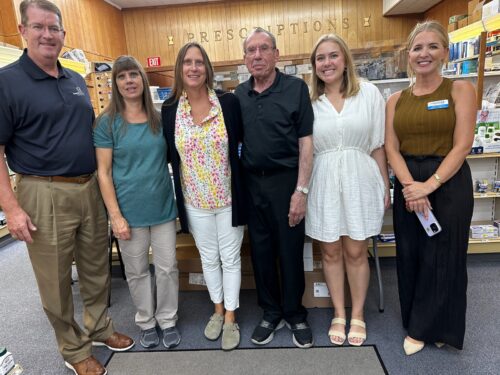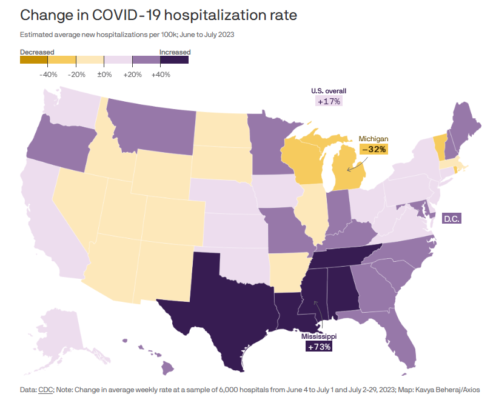What’s on your watchband, gearing up for Covid, improving Plan B, and more
18 Aug 2023
Posted by Andrew Kantor
Insulin: What you can learn from Amazon
A lot of you don’t want to hear about what Amazon is doing in the pharmacy space, but we’re including this story for a specific reason. Amazon has enacted a feature to its pharmacy biz because it realize that patients really, really want it.
In short, Amazon is automatically applying insulin co-pay coupons for patients, rather than having them try to figure out the mess themselves. Why a mess? Because while insulin makers said they would keep co-pays low, that doesn’t mean they made it easy.
Despite Lilly lowering the list price of its Insulin Lispro to $25 per vial in May, patients were still being quoted as much as $330 for the medicine, were not being told about cheaper options when they went to pharmacies, and were finding it difficult to use Lilly’s savings program.
The takeaway here is that there’s a lot of patient frustration around diabetes coupons and co-pays, and any way you can make it easier for patients is going to be appreciated.
AIP is on the move again
It’s a family affair at Mid-City Pharmacy in Canton, Georgia. AIP VP Jonathan Marquess, PharmD, and MSR Ashton Sullivan met with pharmacist, owner, and longtime AIP member Billy Cagle, RPh.

With Billy Cagle are (l-r) AIP VP Jonathan Marquess, daughter Denise Haygood, CPhT; daughter Cynthia Sharp, PharmD; granddaughter Emily Zimmerman, PharmD; AIP Member Service Rep Ashton Sullivan.
Sure, it was great to meet Billy and his staff — and to talk about strategies that could improve his bottom line, but Marquess had a special shout-out for his granddaughter:
“A big congratulations to Emily who not only just graduated from the UGA College of Pharmacy but has already passed her boards!”
Here comes Covid
Numbers keep ticking up
No one wants to hear it, but the numbers don’t lie: Covid cases continue to tick up, and pandemic fatigue means we’re not doing a great job tracking it.
Half-full glass: The numbers are still pretty small, especially compared to the last few years.
Half-empty glass: Yeah, but wastewater analysis, case numbers, and hospitalizations are all pointing to another wave.
Covid hits different parts of the country at different times, and right now the Southeast is where the numbers are rising. In Georgia, hospitalizations rose 32% from June to July, and with testing being spotty that might be the best indicator.

Will the booster work against Eris?
The big concern is how well this year’s Covid booster (which targets Kracken, the XBB.1.5 variant) will fare against Eris (an offshoot of the XBB.1.9.2 variant).
Eris already accounts for more than 17% of cases in the US, but it might be close enough to Kracken that the vaccine will work pretty well. The vaccine makers are testing their drugs, but it’s probably too late to change for this coming season.
States prepare
Health officials across the country are gearing up for the triple threat in what will soon be known as “Respiratory Virus Season*.” Yay. Flu and RSV shots are already available (or are about to be) and the updated Covid vax will be coming soon — hopefully you know this already. The trick will be getting the message to people to take their ounce (or cc) of prevention.
* One official called it “pan-respiratory season,” which doesn’t have the same ring and is missing those capital letters.
A better morning after
The morning-after pill — levonorgestrel — does a decent job preventing fertilization and thus pregnancy. But “decent” means only about 63% effective, so it could be better. How? By adding a bit of piroxicam, the arthritis drug.
A new study out of Hong Kong and Sweden found that “Taking piroxicam […] at the same time as the morning-after pill levonorgestrel prevents 95% of pregnancies.” And there was no difference in side effects.
Caveat: The study involved only Asian women who weighed less than 70 kg (154 lbs in Freedom Units).
Tiny tumor detectors
Why should human beings (or even our coming AI overlords) have to bother detecting colon cancer, when we can get bacteria to do it for us?
Bioengineers at UC San Diego and in Australia have found a way to engineer bacteria (via CRISPR, in fact) to find a particular mutated form of a gene called KRAS that’s present in cancer.
If a bacterium finds that mutated DNA, it lives; if it doesn’t, it dies. Thus the researchers only had to measure the levels of live bacteria to know if there was tumor DNA floating about.
In other words, “The mice with tumors grew green bacterial colonies that had acquired the ability to grow on antibiotic plates.”
Lots more research is needed, but they point out that engineering bacteria to detect cancer cells might also mean they can engineer those bacteria to attack them.
Band of bothers
Bacteria on kitchen sponges, toilet seats, and cell phones — that’s old news. The new hotbeds for pathogens are … rubber and plastic wristbands. Yep, whatever’s holding your FitBit or watch onto your arm might be a Petri dish ringworld.
According to the tests done by Florida Atlantic University researchers…
Staphylococcus was prevalent on 85 percent of the wristbands; researchers found Pseudomonas on 30 percent of the wristbands; and they found E. coli bacteria on 60 percent of the wristbands, which most commonly begins infection through fecal-oral transmission.
Eew.
What to do? Per those researchers, you want to “go for the gold”: “[R]ubber and plastic wristbands had higher bacterial counts, while metal ones, especially gold and silver, had little to no bacteria.”
The Long Read: The GLP-1 Story — a Mystery
Fun fact: Scientists don’t know how GLP-1 drugs work to help people lose weight. They know the results, but the how is a mystery. Here’s a cool story about the discovery and confusion of the new crop of weight-loss drugs.


